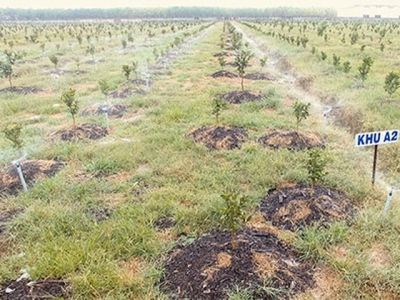The 4th Industrial Revolutions agriculture – the inevitable orientation

Currently, the 4th Industrial Revolution has been strongly coined in, affecting various fields including agriculture. As for the 4th Industrial Revolution’s agriculture, the processes of production shall be applied with modern science and technology which is affirmed by experts as an inevitable orientation.
In the 4th Industrial Revolution’s agriculture, production processes are automated with high yield. In this photo: The automated watering system is operating at mandarin orchard of Le Van Phan in Tru Van Tho Commune of Bau Bang District. Photo: Hoang Pham
Various advantages
Many experts believe that Vietnam is making deeper integration to the world by strongly reformed thoughts in agriculture. Various high-tech agricultural models have been formed to gained preliminary good results. In Binh Duong, the 4th Industrial Revolution’s agriculture was coined in by An Thai High-tech Agricultural Zone in An Thai Commune of Phu Giao District.
Up to date, four high-tech agricultural zones covering over 991 hectares have been implemented in the province at the cost of over VND 900 billion along with 100 high-tech agricultural production models. According to Department of Agriculture and Rural Development, high-tech agricultural production in the province has tended to be developed in terms of quantity and area scales. In cultivation, the in-house and aquaponic vegetable cultivation have been applied along with dripping and misting watering systems. In husbandry various farms have been invested with custody system to mitigate environment pollutions and diseases contributing to the sourcing of safe foods for consumers.
For the gained results in agriculture, the upgrade into the 4th Industrial Revolution’s agriculture shall be more convenient. Nguyen Tan Binh, Director of Agriculture and Rural Development informed that the promotion of agricultural development in the direction of urban, high-tech, and ecological agricultural in combination of processing industries and before hand in the 4th industrial revolution shall be helpful for the sector to meet demands and requirements of farm produce standards in the current process of globalization.
Policies well implemented
Economic experts have warned of insufficient investment resources in putting new technologies into production. In fact, not all enterprises or farmers could invest in to high technologies for their production. It may worth VND 140 to 150 billion which is 4 to 5 times higher than investment into normal farm to construct a high-tech farm while automatic watering and fertilizing system of Israel may cost at least VND 10 to 15 billion.
Currently, along with central government’s policies, Binh Duong Province has issued policies for people to access investment resources for high-tech agriculture including Program 34 of provincial Party Committee for investment luring in 2016-2020 and Decision No. 04 promulgating development of high-tech agriculture in Binh Duong Province in 2016-2020.
Binh informed that the Department shall review, construct and supplement policies for agricultural development to match reality needs and implement agricultural development in the coming time. The Department shall also implement comprehensive restructuring of action plans as the government has approved the project of restructuring agriculture to improve value and sustainable development.
Besides, the Department shall coordinate with related sectors to facilitate start-up in the direction of the 4th Industrial Revolution’s agriculture by promoting application of scientific advancement and technologies into production, semi-processing and processing of farm produces. It can be affirmed that the 4th Industrial Revolution’s agriculture, aside from application of science and technology, requires information to improve agricultural production proficiency, notably the data of product automation processes and smartphones to control the processes.
Có thể bạn quan tâm
 Lao Cai to develop 3.5ha hi-tech farms of lilies, roses
Lao Cai to develop 3.5ha hi-tech farms of lilies, roses The northern province of Lao Cai will use advanced technology to grow lilies and roses across a total area of 3.5 hectares in four wards and township of Sa Pa
 Safeguard tariffs on fertilizer imports hit farmers
Safeguard tariffs on fertilizer imports hit farmers Vietnam’s safeguard tariffs on imports of diammonium phosphate (DAP) and monoammonium phosphate (MAP) fertilizer are delivering a blow to farmers
 Son La Province promotes agricultural branding
Son La Province promotes agricultural branding Vietnam’s agricultural market potential is expanding due to its participation in a growing number of free trade agreements but with fiercer competition pressure